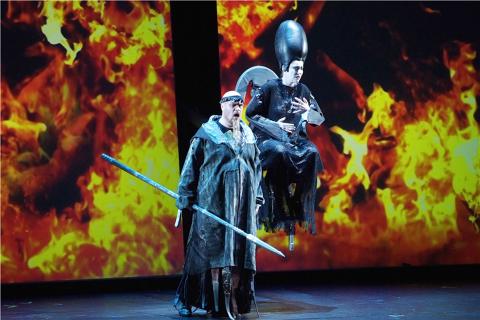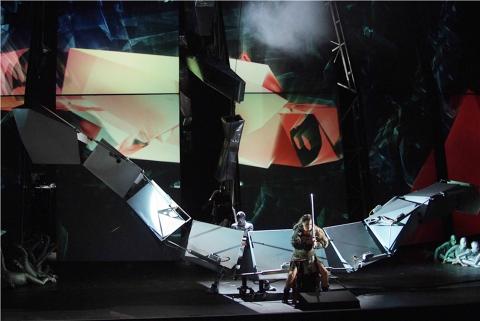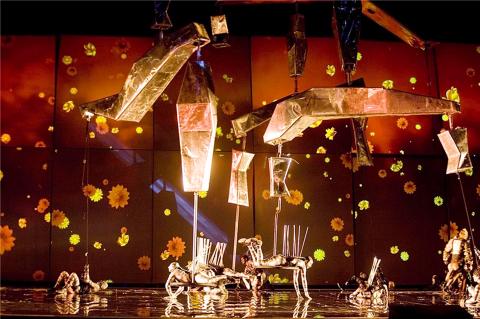The National Theater Taichung (NTT) opened its “The Fall for Great Souls” series last night with the first of three performances of Barcelona-based La Fura dels Baus’ terrific, sci-fi centric production of Richard Wagner’s Siegfried, backed by the National Symphony Orchestra (NSO, 國家交響樂團) under conductor Lu Shao-chia (呂紹嘉).
Siegfried is the first of 10 programs that include Austrian-based Taiwanese choreographer Lin Mei-hong’s (林美虹) The Little Mermaid for the Landestheater Linz Ballet, where she is artistic director, on Nov. 3 and Nov. 4, Etat de siege by the Theatre de la Ville, Cloud Gate Dance Theatre’s (雲門舞集) 45th anniversary show and Hsu Yafen Taiwanese Opera Troupe’s (許亞芬歌子戲劇坊) production of The Soul Switch and Justice Bao (謎魂奇案).
Siegfried, the third of the four operas that constitute Wagner’s The Ring of the Nibelung is a brave choice to start the series, given that the three-act production lasts for five hours, with two intermissions.

Photo courtesy of Tato Baeza
The 39-year-old La Fura dels Baus and Carlus Padrissa, one of the troupe’s six directors, are renowned for their futuristic 3D stage designs and blurring the boundaries between actors and audience, and this production of Siegfried is no exception.
Padrissa’s multimedia vision of the opera, which premiered in 2008 in the Palau de les Arts in Valencia, Spain, with Zubin Mehta conducting, features video projections in three dimensions, an 11m dragon, acrobats, glass floors that reflect the duality of the character.
The sets were designed by Roland Olbeter, the costumes by Chu Uroz and the lighting by Peter Van Praet.

Photo courtesy of Tato Baeza
Padrissa sees Siegfried, a man who does not know who he is or who is parents were, as a man in a permanent state of combustion in his pursuit of the idea of justice for all.
A super-condensed summary of the opera goes like this: a dwarf, Mime, raises a boy, Siegfried, as his own, hoping that he will be able to one day slay the dragon Fafner, which stole a huge treasure from Mime’s brother, Alberich, including a ring that gives is wearer power over the entire planet.
After Siegfried grows up, with the help of a mysterious wanderer (actually the god Wotan), he is finally able to reforge his father’s sword, which he uses to kill the dragon. He also eventually kills Mime, claims the ring of power and rescues a beautiful woman, Brunnhilde, who is meant to be his wife.

Photo courtesy of Tato Baeza
It is a story of treachery, the pursuit of justice and the desire for love: lots of drama, lots of high notes.
The cast includes Vincent Wolfsteiner as Siegfried, Rodell Rosel as Mime, Jukka Rasilainen as The Wanderer and Susan Bullock as Brunnhilde.
The opera will be sung in German, with English and Chinese surtitles.
If the high prices of the tickets are not enough to scare away Wagner or La Fura dels Baus fans, the idea of a marathon performance that starts before most people have had their dinners (5pm) might be, so the NTT is offering a meal service during the intermissions, with advance reservations via its Web site or the NTCH ticketing system.

On April 26, The Lancet published a letter from two doctors at Taichung-based China Medical University Hospital (CMUH) warning that “Taiwan’s Health Care System is on the Brink of Collapse.” The authors said that “Years of policy inaction and mismanagement of resources have led to the National Health Insurance system operating under unsustainable conditions.” The pushback was immediate. Errors in the paper were quickly identified and publicized, to discredit the authors (the hospital apologized). CNA reported that CMUH said the letter described Taiwan in 2021 as having 62 nurses per 10,000 people, when the correct number was 78 nurses per 10,000

As we live longer, our risk of cognitive impairment is increasing. How can we delay the onset of symptoms? Do we have to give up every indulgence or can small changes make a difference? We asked neurologists for tips on how to keep our brains healthy for life. TAKE CARE OF YOUR HEALTH “All of the sensible things that apply to bodily health apply to brain health,” says Suzanne O’Sullivan, a consultant in neurology at the National Hospital for Neurology and Neurosurgery in London, and the author of The Age of Diagnosis. “When you’re 20, you can get away with absolute

May 5 to May 11 What started out as friction between Taiwanese students at Taichung First High School and a Japanese head cook escalated dramatically over the first two weeks of May 1927. It began on April 30 when the cook’s wife knew that lotus starch used in that night’s dinner had rat feces in it, but failed to inform staff until the meal was already prepared. The students believed that her silence was intentional, and filed a complaint. The school’s Japanese administrators sided with the cook’s family, dismissing the students as troublemakers and clamping down on their freedoms — with

As Donald Trump’s executive order in March led to the shuttering of Voice of America (VOA) — the global broadcaster whose roots date back to the fight against Nazi propaganda — he quickly attracted support from figures not used to aligning themselves with any US administration. Trump had ordered the US Agency for Global Media, the federal agency that funds VOA and other groups promoting independent journalism overseas, to be “eliminated to the maximum extent consistent with applicable law.” The decision suddenly halted programming in 49 languages to more than 425 million people. In Moscow, Margarita Simonyan, the hardline editor-in-chief of the